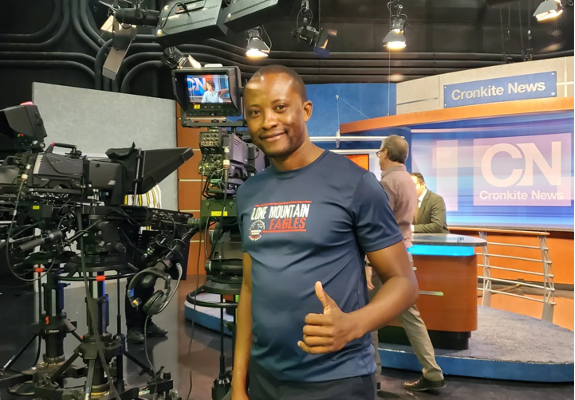I felt like a hungry kid in Charlie’s Chocolate Factory, who was suddenly allowed to eat all the candy that I wanted. So much choice! I got confused and could not decide what to pick and what to leave out. This was my first visit to the Jet Lab’s online equipment booking platform, which we have here at Arizona State University’s (ASU’s) Walter Cronkite School of Journalism and Mass Communication.
As an ASU student I now have the luxury of getting into the elevator and going up to the Jet Lab on the 6th floor where news and film production equipment is stored in neat full shelves. A Few months ago I could only dream about such abundance because my home university in Zimbabwe journalism and media studies students has had only three cameras for many years now. I cannot help but marvel at how privileged ASU’s Walter Cronkite School of Journalism and Mass Communication students are, compared to National University of Science and Technology’s Journalism and Media Studies students.


The vast array of equipment in the Jet Lab.
So far, I have had three trips to the Jet Lab and in all instances, I have managed to check out all the equipment that I need for my video production projects. To make things more interesting, if a student has an out-of-town shoot, ASU assists with funds for transport, accommodation and food, especially if the lecturer teaching the production class also has a grant from which students can benefit. For editing, almost every lab at the Walter Cronkite School of Mass Communication has iMacs and the full Adobe Creative Cloud combo of software. A student at the Walter Cronkite School of Journalism and Mass Communication therefore has no excuse to fail in their work. The only obstacle that stands in a student’s way is the student’s attitude to work.

Journalism and Media Studies students at Zimbabwe’s National University of Science and Technology (NUST) and Journalism and Mass Communication students at Arizona State University (ASU) are like two half-brothers born by the same woman to two different men; a very rich man and a very poor man. Even though these half-brothers have the same mother and basically came from the same womb, their privileges are not the same.
Journalism and Media Studies students at NUST do not have the ‘luxuries’ that are enjoyed by ASU Journalism and Mass Communication students. At NUST, the three cameras, namely two Canon DSLRs and a Panasonic 4K camcorder, were all bought from donor money that was sourced by the lecturers. The cameras do not have tripod for picture stability. There are no memory cards for recording and storing images and video footage. The NUST administration says that there is no money to buy memory cards. A memory card ranges from US$30 to US$240 depending on its storage and quality.
To make matters worse, NUST students do not have the luxury of booking and checking out state-of-art microphones for their video and film production projects. The Department of Journalism and Media Studies does not have microphones. In any given semester, plus or minus 80 students painstakingly crowd around two iMacs in order for them to edit their film projects. They use pirated or ‘cracked’ Adobe Premier Pro because the university does not afford this software.


Left to Right: The NUST Campus and ASU’s Walter Cronkite Campus
The major reason for the difference between the privileges that ASU and NUST students have lies in the tuition fees which they pay. Whilst in-state (Arizona) and out-of-state (out of Arizona) ASU students pay US$24,078.00 and US$40,935.00, respectively, for the entire degree program, NUST conventional (day) and parallel (night) students pay US$4,040.00 and US$4,840.00, respectively, for the entire degree program. In Zimbabwe $4,840.00 is a lot of money to an average family where a student’s father is a school teacher who earns less than US$200 per month, whilst the mother is a housewife. Even though ASU and NUST are public universities, the two universities and their students exist in different geographical, economic, political and socio-cultural contexts.
NUST has tried to increase tuition fees numerous times but they have been opposed by the students, through the Student Representative Council (SRC). The students have always been supported by the government, in their calls for low tuition fees. In Zimbabwe public universities are commonly referred to as state universities and they are under the Ministry of Higher and Tertiary Education, Science and Technology Development. The President of the Republic of Zimbabwe is the Chancellor of all universities. This is why public university are generally referred to as state universities. Tuition fees will not be increased without the government’s approval.
The Zimbabwean government has always highlighted that the mandate of public or state universities like NUST is that of providing affordable education to as many Zimbabweans as possible. Whilst this position is welcomed with open hands by many students and their parents, the downside is that NUST ends up running on a very low budget. The university inevitably ends up failing to provide sufficient teaching and learning resources to lecturers and students. Indeed, ASU students are privileged but the privileges and ‘luxuries’ that they enjoy in all their teaching and learning activities come at a cost, which they have to bear, if they are to continue enjoying them.
In conclusion, NUST students can only enjoy the same ‘luxuries’ that ASU are currently enjoying, only if they pay higher tuition fees. Since it is next to impossible for this to happen, NUST lecturers and students will continue to employ the ‘guerrilla’ way of teaching and learning. It is sad that as a Humphrey Fellow I am being exposed to advanced technology, which my students can only dream of. This is why I hope to develop networks and friendships, which will result in me taking home a few pieces of equipment for use in teaching and learning activities at NUST.
If you would like to see some of the work Jona has produced using Cronkite JET Lab equipment, check out the Humphrey Fellow’s 2022-2023 Welcome video.




